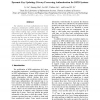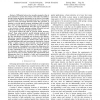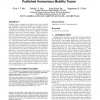6 search results - page 1 / 2 » Privacy through Noise: A Design Space for Private Identifica... |
ACSAC
2009
IEEE
13 years 11 months ago
2009
IEEE
To protect privacy in large systems, users must be able to authenticate against a central server without disclosing their identity to the network. Private identification protocols ...
PERCOM
2007
ACM
14 years 4 months ago
2007
ACM
The objective of private authentication for Radio Frequency Identification (RFID) systems is to allow valid readers to explicitly authenticate their dominated tags without leaking...
SP
1998
IEEE
13 years 8 months ago
1998
IEEE
In developing secure applications and systems, the designers often must incorporate secure user identification in the design specification. In this paper, we study secure off-line...
ICDE
2012
IEEE
11 years 7 months ago
2012
IEEE
— Differential privacy has recently emerged as the de facto standard for private data release. This makes it possible to provide strong theoretical guarantees on the privacy and ...
MOBICOM
2010
ACM
13 years 4 months ago
2010
ACM
Mobility traces of people and vehicles have been collected and published to assist the design and evaluation of mobile networks, such as large-scale urban sensing networks. Althou...



